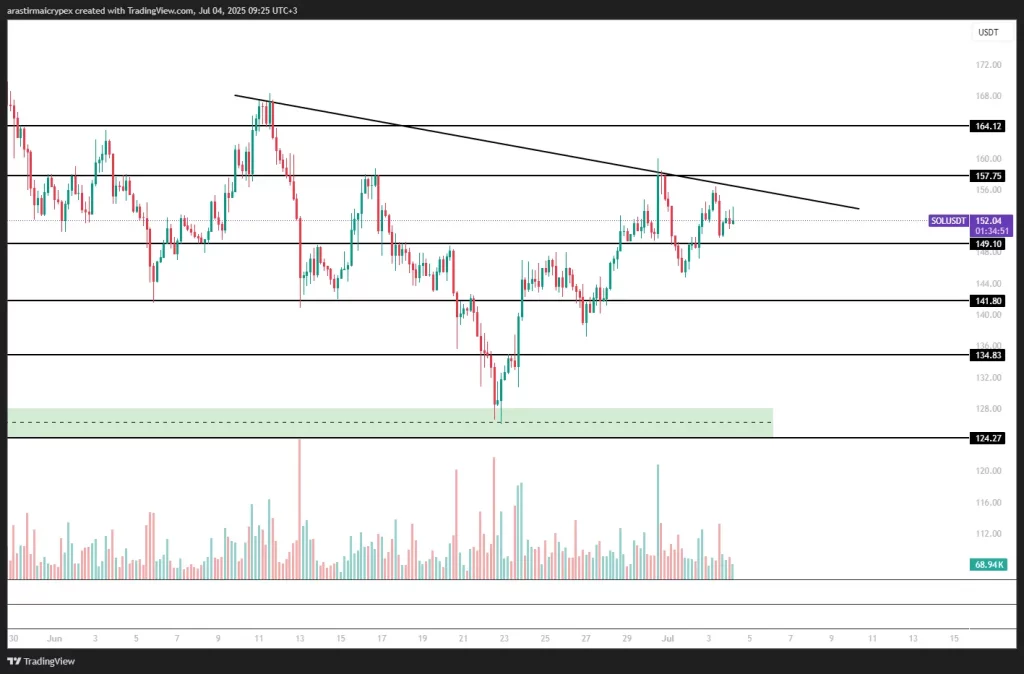House of Representatives to Launch “Crypto Week” – Lummis’ New Bill for Crypto Tax Regulations
House of Representatives to Launch “Crypto Week”
The US House of Representatives has declared the week of July 14 as “Crypto Week.” This week, the stablecoin bill GENIUS, the market structuring act for digital assets, and bills on central bank digital currencies (CBDC) will be discussed. The goal is to pass the House of Representatives and approve the stablecoin regulations, which are expected to reach President Trump’s desk in time. The GENIUS bill approved by the Senate includes requiring stablecoins to be fully backed by US dollars or liquid assets and introducing annual audit requirements. In addition, the “Clarity” bill, which aims to create a clear regulatory framework for the CBDC and digital asset market, is also on the agenda.
These regulations, which aim to fully implement President Trump’s digital asset agenda in the House of Representatives, are stated to aim to protect American financial privacy and make the US the center of the crypto world.
Lummis Introduces New Bill for Crypto Tax Regulations
Senator Cynthia Lummis has introduced a bill that will provide tax benefits to digital asset users. This bill provides that most crypto transactions up to $ 300 will be exempt from capital gains tax payments. In addition, crypto mining and staking rewards will only be taxed when sold, which will ease the tax burden. Lummis’ proposal would also make crypto donations easier and ensure that crypto lending is not taxable.
The bill is being presented as a stand-alone bill that includes tax fixes that the crypto community hopes will be included in President Trump’s sweeping bill. The $300 tax exemption could accelerate the wider adoption of digital assets as a means of payment. Lummis says tax laws should embrace the digital economy and that outdated tax policies should not stifle American innovation.
Grayscale Finds SEC Pause on Solana and XRP ETF “Unexpected”
Crypto asset manager Grayscale called the SEC’s pause on its Digital Large Closed Fund ETF, which includes Solana, XRP, Cardano, Bitcoin, and Ethereum, “unexpected.” Grayscale said the move reflects the rapidly changing regulatory landscape. The SEC had accelerated the conversion of Grayscale’s GDLC fund into an ETF, but delayed the product from trading. The fund tracks the CoinDesk 5 Index, which has a large 80% share of Bitcoin, and also invests in other cryptocurrencies such as Ethereum, Solana, and XRP. Grayscale said it was continuing to work on making GDLC an ETF.
DeFi Dev Corp Strengthens Solana Stock and Staking Strategy
DeFi Dev Corp has strengthened its treasury strategy by purchasing 17,760 SOL tokens, bringing the total to 640,585 SOL. The purchase was valued at approximately $2.72 million, reinforcing the company’s long-term commitment to the Solana ecosystem. All purchased SOL tokens will be staked to various validators, including the company’s own validators, and additional income will be generated through staking rewards. This strategy helps decentralize the Solana network while also allowing the company to generate yields through staking rewards.
By placing Solana at the center of its treasury strategy, DeFi Dev Corp aims to increase both token accumulation and the rewards provided by staked tokens. The company provides direct economic exposure to token holders while also contributing to the application layer development of the Solana network. The move comes as part of DeFi Dev Corp’s efforts to become a strong presence in the Solana ecosystem.
Bitcoin Mining Decreased in June
Many Bitcoin mining firms curtailed their operations in Texas in June due to high electricity demand, sacrificing production in the short term and aiming to reduce costs. Riot Platforms produced 450 BTC in June, a 12% decrease compared to May. The company said its energy strategy includes economic restraint and voluntary participation in the Electric Reliability Council of Texas’ 4CP program.
Cipher Mining similarly produced 160 BTC and sold 58 BTC in June. The company implemented a restraint strategy in an effort to keep energy costs low. However, CleanSpark increased its production by 6.7% in June, producing 445 BTC and selling only 8 BTC, bringing the company’s current Bitcoin reserves to 6,591.
IMF Rejects Pakistan’s Offer of Electricity Rebates for Crypto Mining
The IMF has rejected Pakistan’s offer to lower electricity tariffs for crypto mining and energy-intensive industries. Pakistan has proposed offering low-cost power to utilise its excess electricity capacity, but the IMF has not approved the proposal, citing concerns that such pricing changes could distort the market.
Pakistan aimed to encourage crypto mining and local industrial growth through lower electricity costs, but the IMF is concerned that the plan could further deepen imbalances in the energy sector. The government is in talks with international institutions to revise the plan.
Ondo and Pantera to Allocate $250 Million to Invest in Real-World Assets
Ondo Finance and Pantera Capital have agreed to invest $250 million in projects focused on the tokenisation of real-world assets (RWAs). The initiative, called “Ondo Catalyst,” aims to invest in infrastructure projects and protocols that advance tokenized finance and blockchain-based capital markets. The investment will include a mix of equity and token-based investments.
Tokenization is a rapidly growing crypto use case that is gaining traction among major financial institutions and crypto firms. Ondo is a major player in the field with its tokenized US Treasury bonds and plans to build a sophisticated infrastructure in this area. With Ondo Catalyst, the goal is to tokenize traditional financial instruments, speed up transactions, and expand investor access.
Russian Insurance Companies Introduce Bitcoin-Linked Investment Life Insurance Policies
Two major Russian insurance companies, Renaissance Life and BCS Life Insurance, have launched Bitcoin-linked investment life insurance policies (ILIPs). These policies offer investors the opportunity to benefit from Bitcoin’s appreciation through BlackRock’s iShares Bitcoin Trust (IBIT) ETF. Designed for high-net-worth individuals looking to benefit from Bitcoin’s price movements, the policies provide an alternative way to invest in the asset class without directly holding the digital asset.
Renaissance Life offers a two-year policy that can be started with 1.5 million rubles (about $19,000). If the price of Bitcoin rises significantly, investors can earn up to 2.4 million rubles. BCS Life offers a similar product with a longer-term minimum investment of 3 million rubles, but this policy gives investors the flexibility to rebalance their portfolio. These developments come at a time when demand for Bitcoin-based financial products is growing.
Amber International to Invest $25.5 Million, Buy XRP and SUI
Amber International, a Nasdaq-listed crypto financial services firm, is planning to expand its $100 million crypto ecosystem reserve fund with a $25.5 million private placement. The company aims to direct this fund to major assets such as Bitcoin (BTC), Ethereum (ETH), and Solana (SOL), as well as to invest in Ripple (XRP) and Sui (SUI) tokens. The investment was supported by prominent investors such as CMAG Funds, Mile Green, and Pantera Capital.
Amber International will use these funds to support innovative projects on blockchains such as XRP, BNB, and SUI, and to offer unique products and services to its institutional clients. The company also aims to pursue blockchain innovations in areas such as Real World Assets (RWA) and AgentFi.
——————————————————————————————
BITCOIN (BTC)
BTC is trading at $ 108,850 as of the morning hours, down 0.70%. The price is testing the trend line with the rejection it received from $ 110,507. If the pullback continues, the $ 107,827 level can be followed as short-term support. Below this level, the $ 105,984 and $ 104,750 regions can be followed as strong supports.
In a possible positive trend, the $ 110,507 resistance will become the first target, while the $ 111,924 level may come to the fore if the upward movement continues.
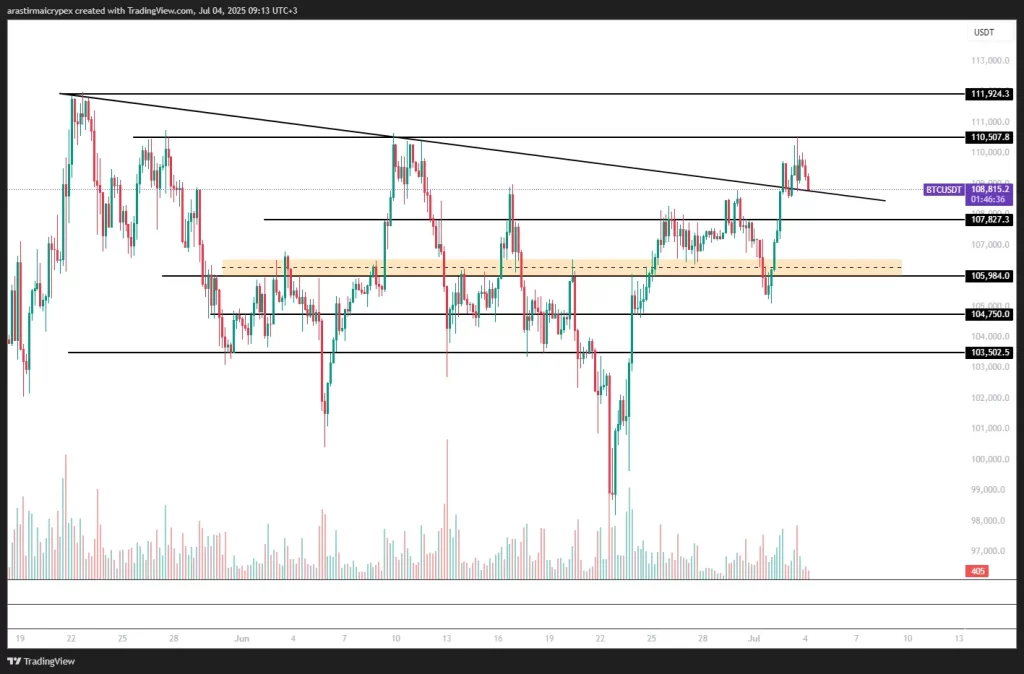
ETHEREUM(ETH)
ETH is priced at $ 2,550 as of the morning hours with a 1.49% loss in value. The price, which rose to the 2,590 resistance yesterday, encountered strong selling pressure at this level and started to retreat.
While the 2,590 level seen in the chart works as an important horizontal resistance, the 2,466 region below stands out as short-term support. In case of declines below this level, 2,392 and then 2,446 bands can be tested again. This region should be watched closely as it has historically been a strong demand area. In order for upward movements to regain momentum, the 2,590 level needs to be broken in volume.
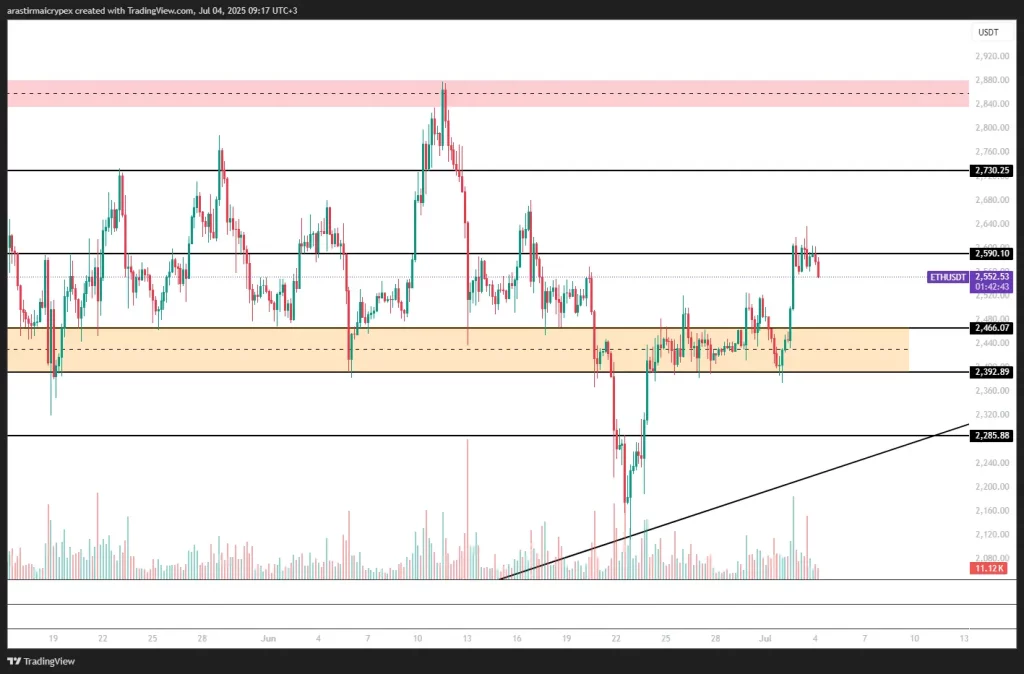
RIPPLE(XRP)
XRP is priced at $ 2.23 as of the morning hours, losing 1.03%. This pullback following yesterday’s rise reflects the selling pressure from the resistance at 2.2767.
The 2.22 support, which draws attention on the chart, works as an important support zone in the short term. If this region is maintained, a gradual pullback to the 2.1764 level may be seen. On the other hand, in the upward scenario, if XRP tests the 2.2767 resistance again, this time if there is a volume break, the 2.3394 level may be targeted.
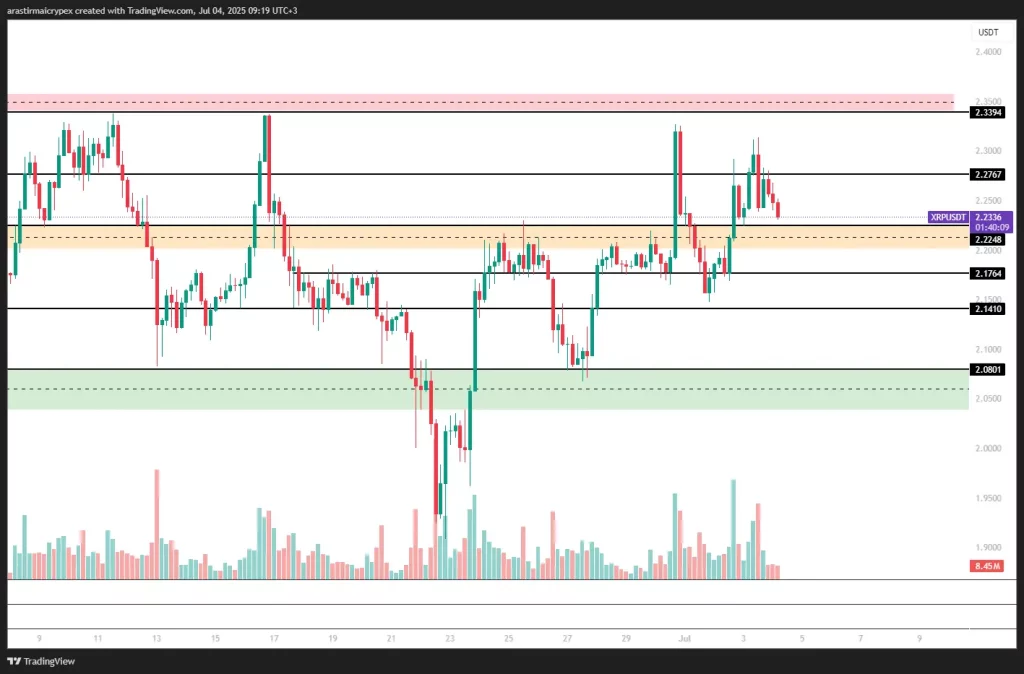
AVALANCHE(AVAX)
AVAX is trading at $ 18.45 as of the morning hours with a 0.49% loss in value. Following the price’s recent upward movement, there is a limited pullback with sales from the resistance zone in the $ 19.24 – $ 20.01 band.
On the daily chart, the levels of 17.63 and 17.07 stand out as short-term support zones. As long as these levels remain above, the possibility of an increase for AVAX remains on the table. In particular, a volumetric break of the 19.24 resistance may enable the 20.01 level to be tested. In the opposite scenario, 16.54 support may come to the fore again at prices below 17.63.
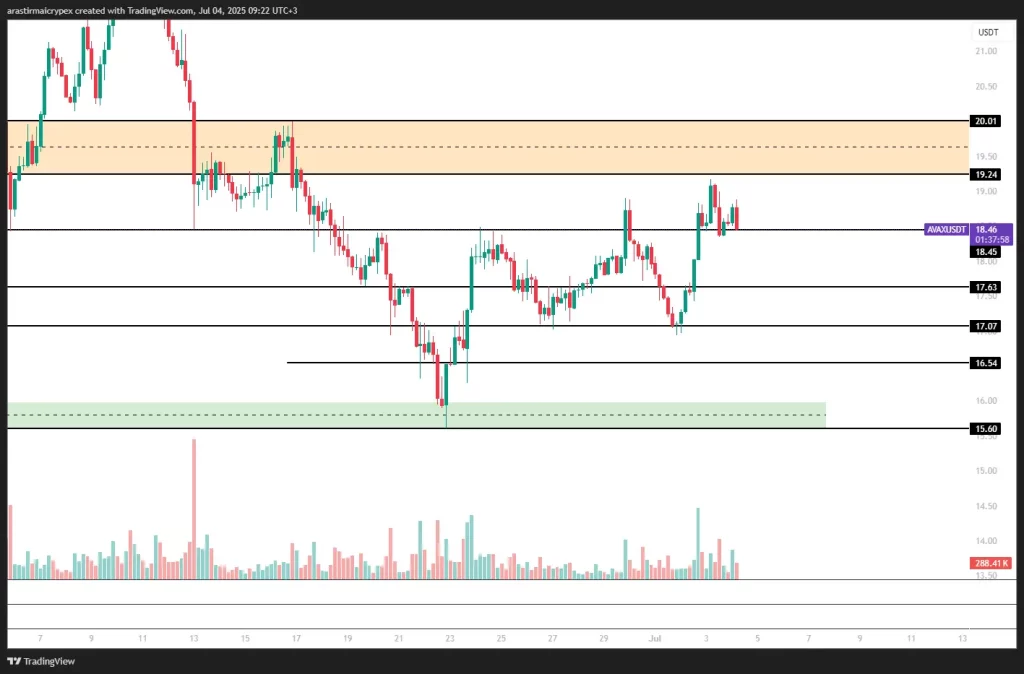
SOLANA(SOL)
SOL is traded at $ 152.10 levels with a 0.11% loss in value as of the morning hours. In the short term, there is a limited pullback with sales from the $ 157.75 resistance.
The fact that the price remains above the intermediate support at $ 149.10 shows that this region maintains its importance for short-term buyers. If 157.75 is exceeded, the strong resistance at 164.12 may be tested again. If the downward pressure increases below 149.10, the support levels of 141.80 and 134.83 may come to the fore.
